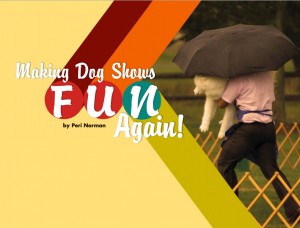Making Dog Shows Fun Again
88 – July/Aug, 2016
by Peri Norman
“Well,” I said to my friend, “shall I pay for some r e s e r v e d grooming spaces or are we going to bring our pop-ups?” Her reply surprised me. “I have a new theory about dog shows”, she said. “Anything that I can do to make it easier and more fun, I am going to do. That includes paying for things that make the show less work, so I can save my energy for the good stuff.” This conversation got me started thinking about the shows and what makes people choose one show weekend over another. There is no question that, on an overall basis, there are too many dog shows for the numbers of people and dogs that we have participating. California, Florida and New England are dog show hotspots.
 There are weekends when I could stay in Southern California, go to Northern California or go to Arizona or Nevada, all for what we consider a reasonable drive. While that may have the benefit of creating more BIS winners, it is certainly not good for the clubs to split entries. On the other hand, my sisters in Montana experience an entirely different picture. Anything under a 12-hour drive is considered local. Weather prohibits dog shows pretty much from the end of September until early April of the following year. While clubs in metropolitan areas can draw a large entry and afford a major venue, rural clubs struggle to survive. The decision to go mid-week between two larger circuits may be the least onerous in a difficult set of choices. Regardless of the situation, virtually all clubs are feeling the effects of a shrinking pool of exhibitors and many are trying to find ways to enhance the dog show experience.
There are weekends when I could stay in Southern California, go to Northern California or go to Arizona or Nevada, all for what we consider a reasonable drive. While that may have the benefit of creating more BIS winners, it is certainly not good for the clubs to split entries. On the other hand, my sisters in Montana experience an entirely different picture. Anything under a 12-hour drive is considered local. Weather prohibits dog shows pretty much from the end of September until early April of the following year. While clubs in metropolitan areas can draw a large entry and afford a major venue, rural clubs struggle to survive. The decision to go mid-week between two larger circuits may be the least onerous in a difficult set of choices. Regardless of the situation, virtually all clubs are feeling the effects of a shrinking pool of exhibitors and many are trying to find ways to enhance the dog show experience.
Another complicating factor is the changing face of show exhibitors. While our established exhibitors are primarily aging boomers, the majority of new owner-handlers are coming from the ranks of empty nest moms whose children are grown. When I started in dogs, the shows were a family affair. If we are going to survive into the future, we need to cater to the established exhibitors for as long as possible so that they are available to provide quality dogs and knowledgeable mentoring for new and less experienced exhibitors. At the same time, we simply must also appeal to a younger demographic. Our current junior handlers are our best hope for the future of our sport. At a young age, they are being exposed to husbandry and breeding skills, as well as show grooming and handling. We need desperately to attract new young
families to our sport. Yes, the dog show is a serious competition requiring preparation and commitment, but attention to the details of making a show more convenient and fun is a win for everyone.
88 – July/Aug, 2016
Short URL: http://caninechronicle.com/?p=107826
Comments are closed











